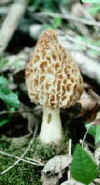| 04-17-06
Well, the spring morel season is upon us (thankfully),
but as the old saw goes: there is good news and bad news on that score.
The good news revolves around the fact that for
the first time in two or three years, the weatherman appears to be cooperating
with morel hunters by ample rain with bright, warm and sunny days. It only
follows, then, that Hoosier morel hunters will find the mother lode in
the next two to three weeks.
The bad news is, that almost before you can pull
on your dilapidated old tennies and head for the woods, there will be dozens
of experts--most having never been eyeball-to-eyeball with a “real” false
morel--declaring that this beautiful fungal growth is poisonous, as in
toxic.
Along that line, there also seems to be confusion
among many armchair fungi experts concerning what is a false morel. Reminds
me a bit of the fellow who saw me returning to my pickup truck last October
with a big bag of shaggymanes.
“Those things can kill you!,” the man said, seemingly
expecting me to scatter my find hither and yon with a flourish, and burn
rubber getting out of there.
“I may die after feasting on them (fried to a
golden brown), “ I said, “but if I do, it will be on a full tummy
of gastronomic delight.”
“Well, don’t say I didn’t warn you,” the man said,
continuing his walk with head shaking to match his strides.
The experts who warn that the false morel is poisonous
and that it is easy to mistakenly pick and consume it as a true morel are
about half correct on the first count, and totally wrong on the second.
The “real” false morel, as we know it in this
part of the mycological kingdom called the Midwest, is a member of the
Gyromitra
family. Gyromitra gigas, the reddish-brown false morel that we encounter
most often, has a beautiful white stem (with interior chambers) that is
about as wide as the wrinkled (brain-like) cap that reminds me of
the texture of the back of a soft-shelled turtle. The cap of the mushroom
is more fragile than the back of the turtle.
Conversely, the true morel sits on a hollow, white
stem that seldom is as wide as its cap. And the sponge-like surface of
the true morel cap does not in any way resemble the cap of the false morel.
Missourian Jack Chipley recently told me that
he is 70 years old and that he has eaten false morels all of his life.
“In many cases, I prefer them (false morels) over the true morels and
never had any ill effects . . . we called them red mushrooms.” Chipley
says.I, too, have eaten the false morel in the past, but in view of the
fact that Gyromitra gigas could be mistaken for Gromitra
esculenta or Gyromitra infula, both said to be poisonous, I
do not eat any member of the family, nor do I recommend that anyone
else eat them.
However, I have never found either of the poisonous
Gyros
in Indiana or any other place. Most of the gigas I have found have
ranged up to three to four inches wide at the cap and about the same height.
But someone from northern Indiana once sent me a picture of a gigas
that was as big as a gallon paint bucket.
Although it is not known as a “false morel,” another
fungal family--Verpa (a k a “thimble morels)--could be mistaken
for Morchella semilibera, known in mixed company as the spearhead,
but having other names.
Technically it is Verpa bohemica, and it
is said to be edible with caution if cooked. The cap of this fungi does
resemble the cap of the spearhead, but the two can be distinguished by
the point at which their stems are attached to their caps. As the “semilibera”
designation suggest, its cap is only partially free of the stem. The stem
of this fungi is attached to the cap about halfway up to the apex of the
cap. The stem of Verpa bohemica is attached at the apex of the cap.
Caps and stems of the “true” morels are joined
at the lower perimeters of the caps.
My semi-scientific observations over the years
also tend to note that the stem of bohemica is more coarse, and
more brittle, than that of semilibera. Though the stems of both
mushrooms are hollow, that of bohemica may be partially filled with
a pith-like material.
Although the spearhead is eaten by many, I do
not harvest it often because it (or its look-alike, bohemica) once
gave me a case of the shakes after I had loaded up on them on an empty
stomach. It was not a serious thing, but I still remember the episode when
I encounter the spearhead or its mimic.
Click on
thumbnail image for enlarged view.

|

|
|
True
Morel
|
False
Morel
|
|
| There
is no way the true morel and false morel can be confused. |
|

